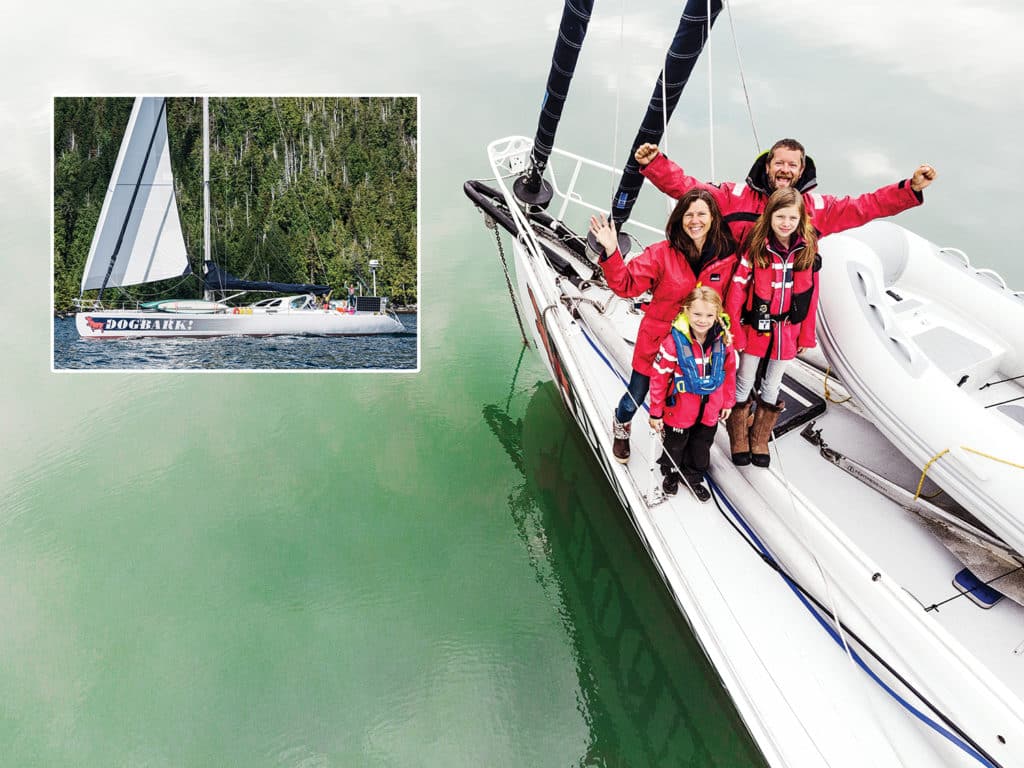
The sun peeked over the gentle rolling ocean swell, smearing the underside of the clouds with Crayola colors. Janna Esarey sat on a creatively fashioned dock box-turned-cockpit seat as DogBark galloped across the Pacific at 10 knots, under a reefed main and full genoa. She was sailing almost due south, 900 nautical miles north of Hawaii, with 25 knots of breeze over the port beam. DogBark was in her element, with the strong trades fueling her drive to sail fast. Janna’s confidence in her boat’s aptitude permitted her to sip coffee casually while admiring the stunning sunrise. She contemplated the winding path that led to this moment, charging across the Pacific on a 60-foot boat she had learned to love and call home. This is the story of a family, a quest and a yacht called DogBark.
Like a complex puzzle, revealed one piece at a time, the tale begins decades earlier with a unique distance-racing sailboat built halfway around the world. It meanders across a coincidental meeting between two equally passionate (read: crazy) racing sailors, and a compelling conversation with an Arctic explorer. And finally, in its third act (thus far), it lurches through an intense year of boat renovations before ice conditions wrench the storyline from a wintry 71 degrees north to a tropical 20 degrees north.
The first puzzle piece materialized in 1989 when Australian Kanga Birtles, owner of Jarkan Yacht Builders, splashed his newly designed, custom racing sailboat, designed by John King and built in accordance with the relatively new Open 60 (now called IMOCA 60) box rules. The boat, christened Jarkan Yacht Builders, came in at just under 60 feet, with a 9.5-foot draft and enough positive stability to right itself from a deep knockdown. At the time, at least in the Open 60 realm, it was a conventional design, with a fixed bulb keel, a single rudder, 30,000-pound displacement, and about 10,000 pounds of water ballast in tanks extending 18 feet along each side of the hull. Birtles had the 1990 BOC Challenge in mind, a solo around-the-world race, and being on a restrictive budget without major sponsorship, wanted a “bulletproof” boat to limit costly and potentially dangerous breakages midrace.
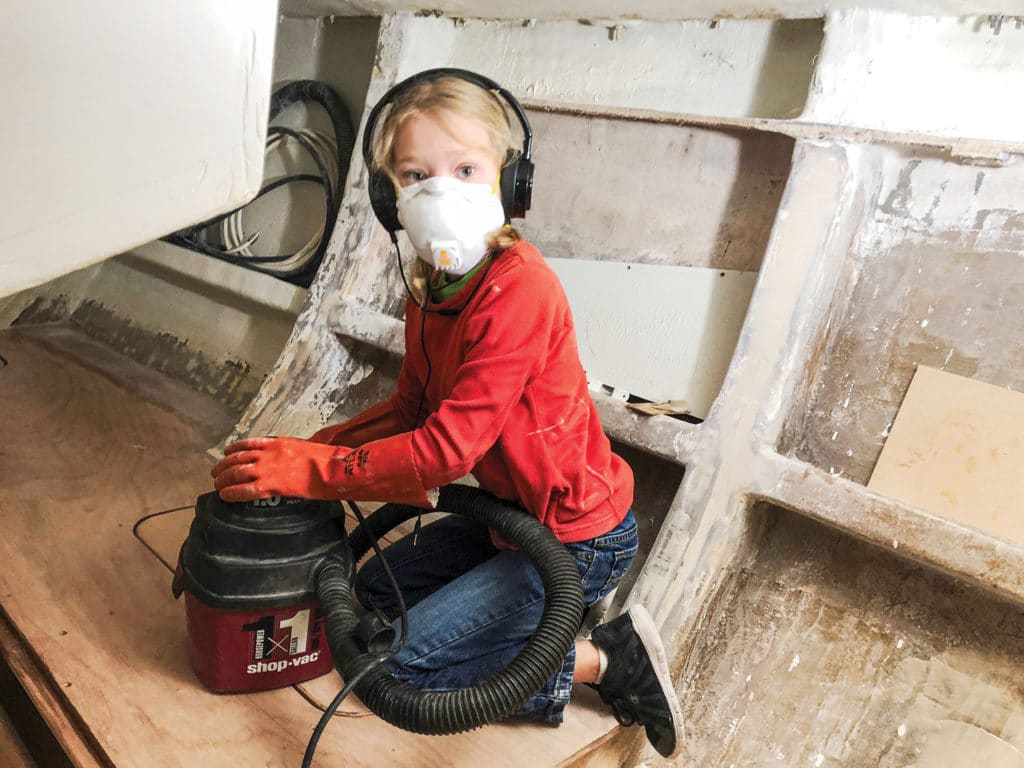
The BOC Challenge (renamed the Around Alone race in the 1990s) was, at the time, the world’s premier singlehanded event. Of the 25 vessels that left Newport, Rhode Island, in fall 1990, with dreams of returning half a year later both intact and ahead of their competition, seven withdrew due to damage, injury or both. Completing the race was a testament to the strength and fortitude of man and vessel. In May 1991, Jarkan crossed the finish line fifth in its class.
An offhand comment from Birtles after the race underscored his vessel’s fortitude. Despite a chilling knockdown in the Southern Ocean during the race’s third leg, the only damage Jarkan sustained in 136 days of racing were a few bent stanchions. Birtles had built a fast, robust vessel capable of withstanding the toughest ocean conditions on the planet under the guidance of a lone crew.
Twelve years later, that sleek, sturdy Open 60 called to Al Hughes from the docks in Seattle. Al wasn’t looking for a new boat, but Primetime America, its name at the time, was looking for a new owner. Al already owned a boat; he lived aboard a custom 39-foot sailboat with his wife, but was drawn to Primetime’s sexy lines and long-distance ocean-racing credentials. She was going through a rough patch, owned by a bank looking to recoup its losses, and desperately needed an infusion of new energy.
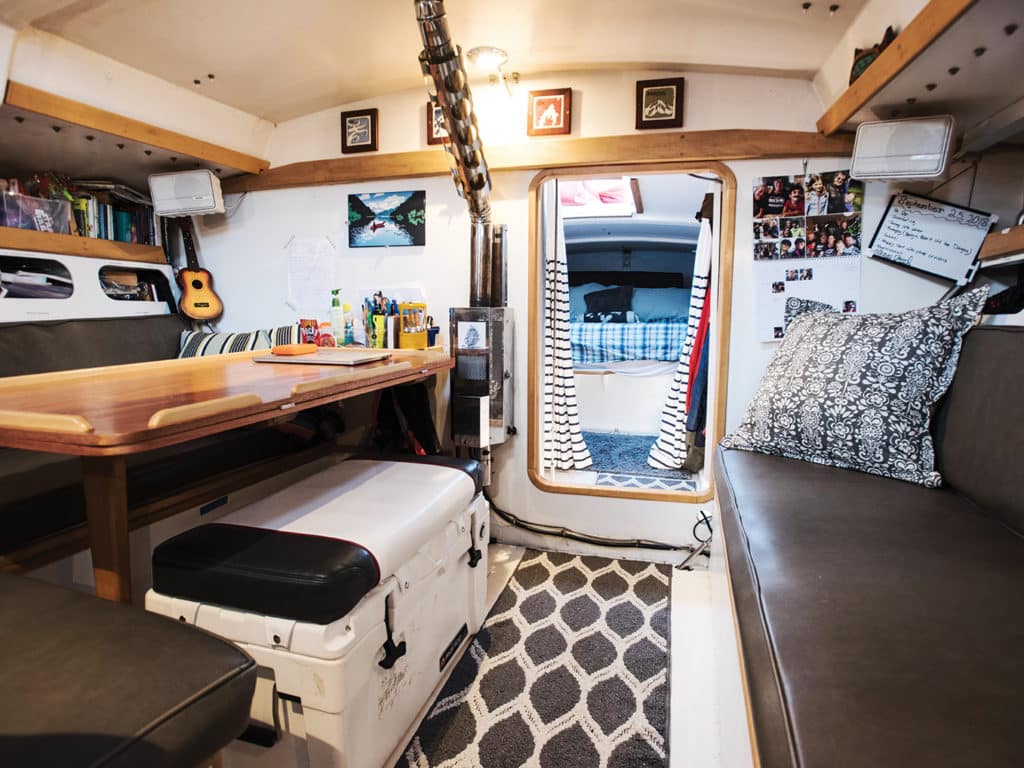
Much to the chagrin of his usually loving and supportive wife, Al’s absurdly low offer was accepted, and he became a two-boat owner in January 2004. The renowned Open 60 was rechristened DogBark, a tribute to his pup, Gus, and a tongue-in-cheek reference to “dog-bark navigation,” in which sailors in Scotland’s fog-shrouded waterways listened for the sound of barking to know when they were too close to shore and needed to tack away into deeper waters.
Al’s friends told him he was crazy, but his ambitions crystalized with his admiration of DogBark. He’d hustle to the start line of the Singlehanded Transpacific Yacht Race in San Francisco, five short months away, to see what she could do. Al assured his wife he’d do one singlehanded race before selling the boat. Short on time and money, he changed little about DogBark, adding only the required safety equipment and replacing spent batteries and a few fraying lines. After one qualifying sail, he headed to the start line in June, with a perilously low number of hours spent sailing the boat.
But DogBark took care of him. Twelve days later, he took line honors in Kauai, Hawaii (a mere 45 minutes ahead of the second-place finisher), and sealed his love for the boat that carried him there. While 60 feet is a lot of boat to handle alone, and challenging weather conditions kept Al on his toes, DogBark made his job as easy as she could, barreling across the ocean without complaint. He hit a top speed of 24 knots, a wild sleigh ride down a particularly steep wave that had him holding on and shouting with glee. Despite his wife’s urging, Al couldn’t part with the boat. He returned to take line honors in the 2006 and 2008 editions of the singlehanded Transpac. So much for his one-and-done promise.
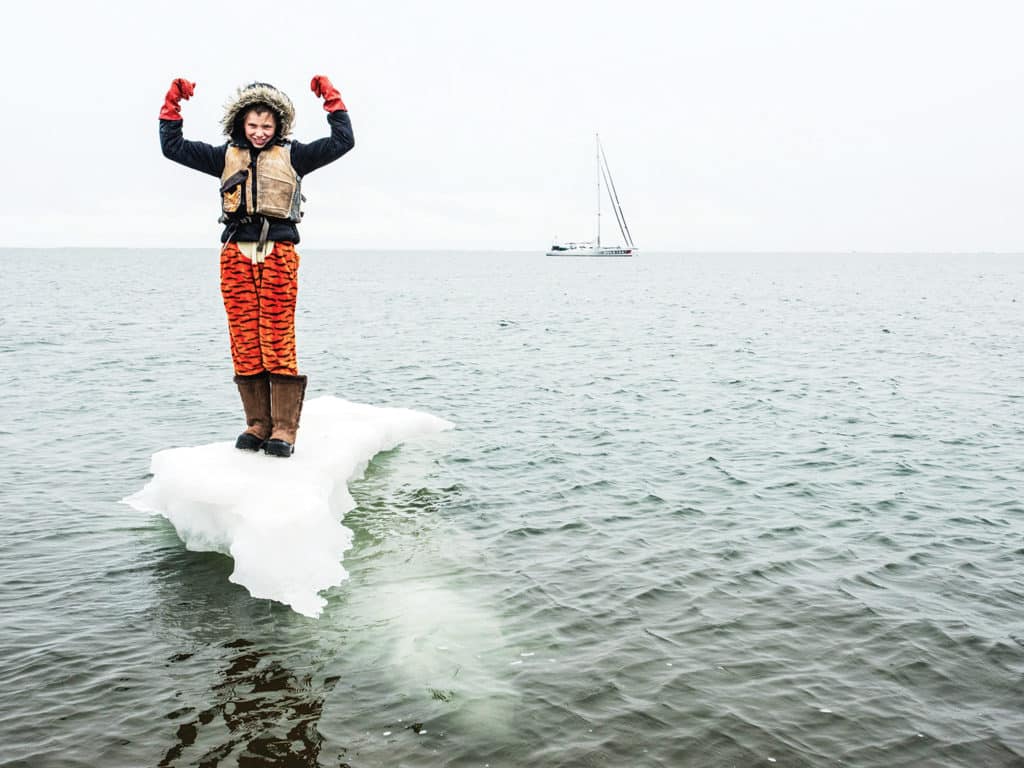
While Al was galloping across the Pacific on DogBark, a newly married couple untied the lines of their Hallberg-Rassy Rasmus 35, Dragonfly, for an extended honeymoon cruise. On their two-year voyage across the Pacific, Graeme and Janna Cawrse Esarey fortified their loyalty to each other and to the sea. When they returned to Seattle to start a family, it was with the knowledge that the ocean would call them back to cruise as a family one day.
In the following years, their daughters, Talia and Savai, grew into precocious individuals and confident sailors, and Graeme fostered a dedicated and competitive race crew for his Farr 1220, Kotuku. In the way that happenstance interactions can inadvertently alter the narrative of those interacting, another puzzle piece dropped into place when Al found himself racing with Graeme…and Graeme in turn found himself admiring Al’s immense knowledge and skill.
Graeme soon learned Al had a fast boat of his own. And, in the way that seemingly inanimate objects can wiggle their way into the heart of an unsuspecting observer, Graeme fell in love with DogBark the first time he saw her standing proudly in a boatyard near Seattle. As a long-distance-racing enthusiast, he fantasized about the adventures he could have with a boat designed to sail with a small crew anywhere in the world. But practicality kept him grounded; he already owned a wonderful boat for racing in the Northwest and, anyway, DogBark’s utter lack of interior comforts would not sit well with his family.
It was not until Graeme talked to polar explorer Eric Larsen that the puzzle’s outline came into focus. He and Janna wanted to take their daughters, now 10 and 12 years old, cruising before high school commitments took precedence but were struggling to find enthusiasm for the tropical route they took on their honeymoon cruise. Janna had learned she preferred cold-weather sailing, and with the world so big, taking the same path through the tropics felt uninspiring. Eric, recently returned from an unsupported expedition to the North Pole by foot, mentioned the Northwest Passage’s growing water-to-ice ratio. Walking across the ice wasn’t on Graeme’s radar, but exciting cold-weather cruising grounds were. Furthermore, that sturdy, oceangoing racing machine sitting in the boatyard had been calling to Graeme for years.
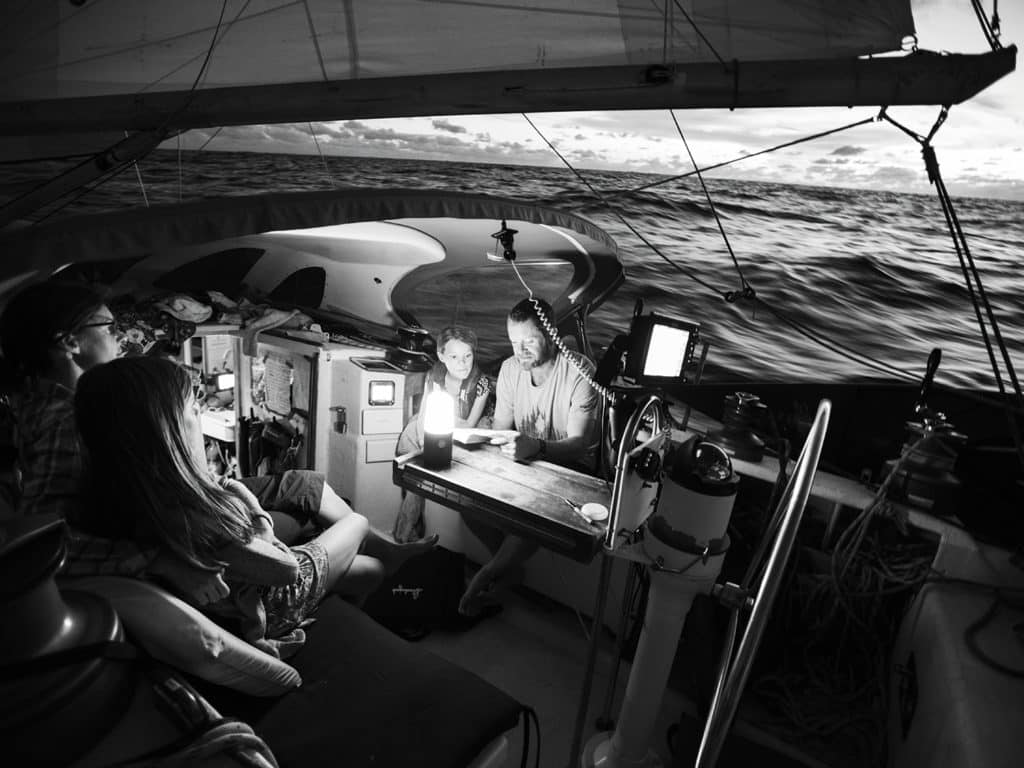
The rest of the family was—OK, tentatively at first—on board with the harebrained idea to buy DogBark, refit her in less than 12 months, and leave Seattle to sail through the Northwest Passage before continuing to the Mediterranean. Dreaming became planning, and planning soon became doing. Al, understanding the drive to pursue wild sailing dreams better than most, handed over the keys to DogBark, along with a seemingly limitless stream of advice and knowledge.
Shortly after ownership passed hands, my husband, John, and I were incorporated into the wild scheme. We had raced with Graeme and Al aboard Kotuku until, inspired by their knowledge and passion for sailing, we had purchased our own boat and left Seattle to go cruising. When Graeme called us in Nicaragua with the news of their “new” boat and their related Arctic plans, it took us less than a breath to commit to join them for the Northwest Passage. As a writer/photographer team, we would be able to document the journey while contributing as crew, and stand-in aunt and uncle to Talia and Savai.
As friends had with Al, Graeme and Janna’s pals regularly informed them they were crazy. The Northwest Passage, while a significantly more feasible route than a decade earlier, was still far from a sure thing. DogBark’s fiberglass hull and deep draft were concerns in a region dominated by perilous ice and shallow bays. But for Graeme and his crew, those concerns were offset by her watertight crash bulkheads and a thick, sturdy hull. DogBark was designed with high-latitude sailing in mind.
When Al had prepared to do his second and third Transpac, he’d touched up the bottom paint on DogBark, changed the oil, tested a few systems, and took off for the start line. The list of requirements and comforts for a two-week solo passage in temperate waters was concise. That list grew immeasurably longer as the Esareys considered a multiyear cruise for four people, starting with two extra crewmembers and a month or more of voyaging above the Arctic Circle. DogBark had a strong hull and an engine with low hours but lacked creature comforts—such as beds or a bathroom door—that would make living aboard suitable for the whole family.
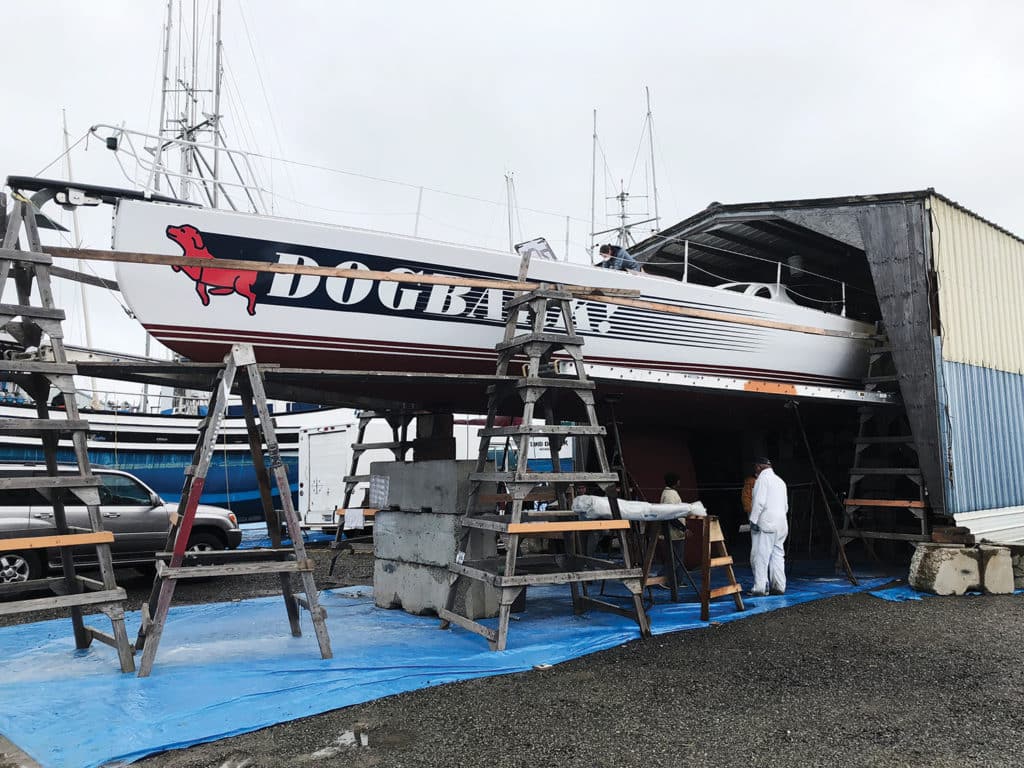
So they all got to work. They crafted a “Master Project List,” a shared Excel document pages long with notes, dimensions, priorities and dates. Step one required several power washers and elbow grease to clear the deck’s flourishing farm of moss and mold. Step two was…everything else.
From the very first day, it was clear there was not enough time to do it all. Many boat owners spend three or seven or 15 years preparing themselves and their boat to go cruising. The Esareys had less than one. Other boat owners dream of it all their lives but are never quite able to untie the lines. Graeme and Janna were well-aware of the traps of shore life, so once the plan was hatched, they were determined to untie the lines the following summer, even if it meant sailing north before the water tanks were plumbed or heaters installed. With a long list and a short timeline, Graeme and Janna divided tasks and dug in.
Graeme focused on ensuring DogBark was as safe (and fast) as possible. He worked with Port Townsend Rigging to replace all of the rod and wire rigging, including fabricating new spreader ends and replacing all of the turnbuckles. Under Al’s guidance, he added a bowsprit to make flying and jibing the asymmetrical kites easier, and to extend the anchor away from DogBark’s plumb bow. Ballard Sails issued a new suite of working sails: a main, a genoa and a jib, and recut two spinnakers. Graeme added all new B&G electronics, an autopilot, and an electric winch to assist the new mainsail up the 85 feet of mast. He expanded fuel, fresh water and waste capacity. He purchased a new life raft, two solar panels and an engine-driven heater, but he didn’t have time to install them before departure.
One of DogBark’s qualities that enticed Graeme was her shorthanded sailing prowess. Built for singlehanding, the sail controls were designed for one person to make sail changes and adjustments, despite the loads of a 60-foot boat with a nine-story spar. Almost without exception, whenever Graeme changed the way a line was led, he soon re-led it the way it was originally. He updated the banks of clutches and replaced worn lines, but otherwise found that the leads, winch placements and reefing systems worked most effectively unaltered. DogBark was well-sorted.

Janna focused on the interior renovation. While safety and speed were tantamount, cruising with a family required converting the interior from a simple layout, one designed for a single, low-maintenance racer, into a practical and comfortable home with storage and sleeping space. She knew her husband would happily sail in a bucket (as long as it was a fast bucket), but the rest of the family wanted some level of comfort and amenities. DogBark had only one real “bed” (which had morphed into space for storing sails), so the biggest challenge was converting the aft spaces on either side of the companionway from water ballast tanks into cabins. In the end, they ground out 9 linear feet of ballast tank on either side, pulled out the large aft-facing nav station, and custom-built single bunks that converted into doubles. To make it homey, Janna’s father added shelving to cover the ballast tank and a pocket desk controlled by a line that allowed it to “gimbal” when the boat heeled. Doors would give the sisters some form of privacy but, without time to custom-make them, decorative shower curtains sufficed.
Once Talia and Savai saw their rooms taking shape and realized their parents were truly committed to this adventure, the dream felt real and they started to get excited. Having grown up on and around boats, they knew the demands—and the potential fun—of boat work. While their friends spent lazy afternoons at the park or playing video games, Talia and Savai were on the boat with their parents, getting dirty and working hard. They helped paint every exposed inch of the interior, cover the audacious yellow Formica countertops with a more pleasing slate gray, and re-cover the bright red saloon cushions with easy-to-clean faux leather. They ran wires through the engine room, scrubbed the bilge, installed wood paneling, and went up the mast to run new halyards. They brought energy and silliness to the boatyard, alongside their hard work and creative solutions.
Many projects that started out with a prominent place on the master list soon dropped off the back, due to a shortage of time or a change in perspective. DogBark came with a funky space-pod-looking hard dodger with crazed plexiglass windows that wouldn’t offer much visibility or protection from the cold bitter elements of the Arctic. The family agreed the dodger needed to be replaced. But designing something better within their time and budget restraints proved impossible. They made what felt like a compromise by simply replacing the plexiglass, and adding a frame-and-canvas cockpit enclosure to the back of the dodger, and marked the project done. Soon, though, they all agreed it was the right decision. DogBark maintained her sleek, sexy lines without the addition of a bigger, boxier dodger, and the canvas enclosure expanded the living space while maintaining visibility and flexibility for any weather condition.
Time is unbiased. It does not care how busy we are or how long our project list still is. Soon it was spring and nearly time to go. John and I entered the mayhem a few weeks before untying the lines, and jumped straight into final preparations. We installed hardware, tested systems, bought parts, stowed gear and went provisioning. In a blink, our departure date arrived. When we left the dock in Port Townsend, Washington, in spring 2018, most of the gear was still in boxes. Solar panels leaned against the stern rail, wrapped in foam and cardboard. Only half of the water tanks were plumbed. Tools were scattered across the new saloon table. But the bilge was full of canned goods, the aft lazarette was full of topped-off diesel tanks, and the new cruisers were full of excitement and appreciation. The puzzle was complete. The Esareys had made a commitment to each other, to DogBark and to themselves, and they were not shying away from that. It was time to go cruising.
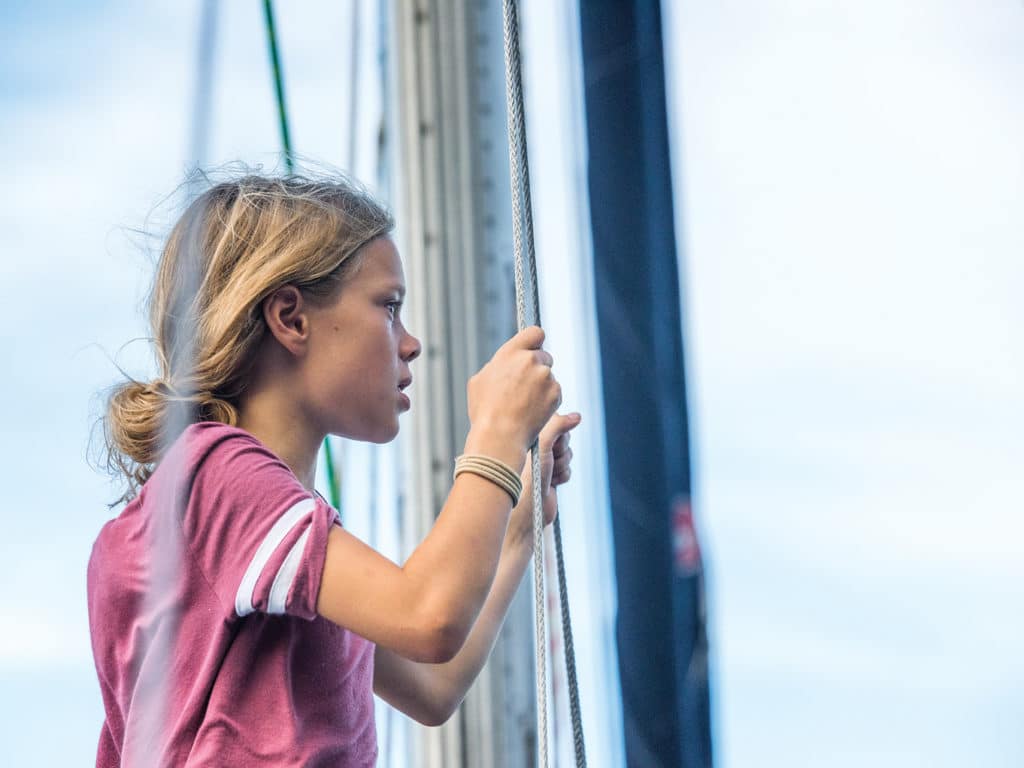
Graeme knew he would cherish DogBark’s speed, but Janna, who had never called herself a racer, had never considered performance as a boat’s most important feature. But this boat won Janna over from their first sail, and in the following months, DogBark demonstrated her confidence and grace again and again. She ghosted across the Strait of Juan de Fuca, effortlessly reaching 8 knots in a wispy 9 knots of true wind; she powered through strong choppy seas in the Gulf of Alaska and easily legged out ahead of a low-pressure system bearing down on her in the Bering Sea. When a strong headwind contradicted a swift current in the shallow waters of Hecate Strait, the spiteful seas opened the forward hatch, filling the bow locker with seawater and effectively testing the strength of the soon-to-be-revered forwardmost watertight bulkhead. Despite an extra few thousand pounds of weight, DogBark sailed on, a bit sluggish but mostly unperturbed, until her crew discovered the intrusion and pumped the water back outside the boat, where it belonged.
Unfortunately, despite DogBark’s preparation and enthusiasm, ice conditions barred almost every boat from transiting the Northwest Passage that summer. Of the 25 boats to attempt the passage, only two made it through. Many more were damaged by ice, and one sank after colliding with an iceberg. The rest turned back to try their chances another year, DogBark among them. Having sailed past 71 degrees north and east along the north slope of Alaska, DogBark tucked her tail and sprinted nearly 4,000 miles in three weeks to thaw out her crew in the lush green paradise of Hawaii.
It is a testament to DogBark and her new caretakers’ renovations that she was just as comfortable tiptoeing past icebergs in the Chukchi Sea as she was galloping across the Pacific under a big colorful spinnaker. It is a testament to her crew that when one door closed, they were able to realign their aspirations and expectations, turn south, and take off for new Hawaiian cruising grounds.
And so, we end this chapter of DogBark’s ongoing story by picking up where we began:
As the sun climbed higher, pushing new heat into the already warm tropical morning, Janna relished in her quiet moment with DogBark, again thanking the old girl for taking such good care of her family. It had been a wild ride so far—the decisions, the boat projects, the learning, the Arctic rejection, the ocean miles—yet she knew the adventures with this marvelous boat had only just begun.
After leaving DogBark in Hawaii, Becca Guillote and her husband John completed an ocean crossing on their Valiant 40, Halcyon, sailing 4,000 miles from Panama to French Polynesia. Read more on their travels on their blog. Meanwhile, the Esarey family continued onward from Hawaii to the Marquesas and Tuamotus before returning home to Seattle.








